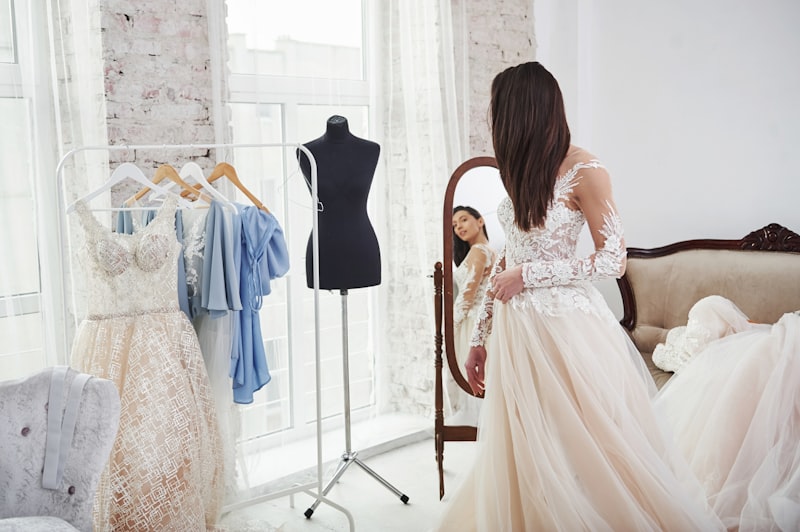Exploring Customization Options for Wedding Gowns: A Guide to Your Perfect Dress
Exploring Customization Options for Wedding Gowns: A Guide to Your Perfect Dress
Your wedding day is one of the most important events in your life, and finding the perfect wedding gown is essential to making it memorable. While ready-made dresses can be beautiful, customization options for wedding gowns allow brides to create a unique piece that reflects their personal style and love story. In this article, we will explore the various customization options available, discuss how to choose the right style, and provide tips for navigating the customization process effectively.
Understanding Customization Options
Customization options for wedding gowns can include everything from fabric choice and color to necklines, silhouettes, and intricate details. Below is a summary of the main customization features that brides-to-be can consider:
| Customization Feature | Description |
| Fabric | Choose materials like satin, lace, tulle, or chiffon to achieve the desired texture and look. |
| Color | Select from traditional shades, such as white or ivory, or go bold with colors that express your personality. |
| Necklines | Opt for various necklines like sweetheart, V-neck, or off-the-shoulder to suit your style. |
| Silhouettes | From A-line and ball gown to mermaid and sheath, the silhouette defines your gown's overall shape. |
| Embellishments | Add beading, sequins, embroidery, or lace appliqués for an elegant, personal touch. |
| Length | Custom length adjustments can ensure a perfect fit, whether you want a floor-length gown or a chic tea-length dress. |
Choosing the Right Style for Your Wedding
One of the most crucial steps in the customization process is determining which styles resonate with you. Consider the following aspects while selecting the right gown:
Your Body Type
Understanding your body shape is essential when choosing a wedding gown. Certain silhouettes complement various shapes better than others. For example, A-line dresses flatter most body types, making them a popular choice among brides. In contrast, mermaid gowns accentuate curves and are ideal for hourglass figures.
The Wedding Theme
Your wedding theme can significantly influence your gown choice. For a rustic outdoor wedding, a flowing bohemian dress may blend well with the surroundings. Conversely, a formal black-tie affair might call for a sophisticated ball gown. By aligning the dress style with your wedding theme, you ensure a cohesive look on your special day.
Fabric Selection
The fabric you choose will impact not only the gown's style but also its comfort and suitability for the season. Lightweight materials like chiffon or tulle work well for summer weddings, while heavier fabrics like satin or velvet are excellent for winter celebrations. Consider consulting with your designer about fabric options that complement your chosen gown design.

The Customization Process
Once you’ve identified your preferred styles and features, it's time to begin the customization process. Here are some tips to ensure a smooth experience:
Find the Right Designer
Research designers who specialize in customization options for wedding gowns. Look through their portfolios to assess their craftsmanship and style. Seek recommendations from friends or family who have had positive experiences, and read reviews to ensure quality service.
Schedule a Consultation
During your consultation, discuss your ideas and preferences openly. Bring inspiration photos to help convey your vision, and be prepared to share your budget. A good designer will work with you to explore various options that align with your desires while considering your financial constraints.
Get Measured
Accurate measurements are critical for achieving a perfect fit. Most designers will take your measurements, but if you're opting for a dressmaker, ask about their measuring techniques. Ensure you wear undergarments similar to what you plan to wear on your wedding day, as these can affect the fit of the dress.
Fittings and Alterations
Once the designer has created your gown, you’ll have fittings to fine-tune the fit and make adjustments. Don’t be afraid to voice your thoughts during fittings; it’s your gown, and open communication is crucial for desired alterations. Typically, expect to have two to four fittings, with the final one scheduled closer to your wedding date.
Budgeting for Customization
Customization options for wedding gowns can vary significantly in price, influenced by fabric choice, design complexity, and the designer's reputation. Here are some budgeting considerations:
- Fabric Costs: High-quality fabrics, especially silks and intricate laces, will raise your budget.
- Designer Experience: Renowned designers may charge higher fees based on their expertise and popularity.
- Embellishments: Unique customizations, such as hand-stitched embroidery or bespoke beading, will contribute to higher costs.
- Alteration Fees: Frequently, additional charges apply for alterations beyond the standard adjustments.
To stay on budget, set a clear limit for what you're willing to spend on both the gown and its customization. Allocate a percentage for alterations and additional costs to avoid surprises.
Final Thoughts and Recommendations
Customization options for wedding gowns provide a unique opportunity to reflect your personality and style on your big day. When selecting your gown, consider your body type, wedding theme, and comfort. Take your time in the customization process, communicating openly with your designer to ensure your vision comes to life.
As you embark on this exciting journey, keep in mind that the most important element of your wedding gown is how it makes you feel. Ultimately, your perfect dress should empower you and add to the joy of celebrating your love. Remember to enjoy the process, celebrate your individuality, and trust that every detail you choose will contribute to a magical and unforgettable wedding day.
